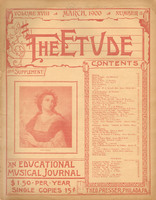Recently a gentleman informed me that his little son was the possessor of a fine Nicholas Amati violin, genuine beyond any possibility of a doubt. When I questioned him as to its state of preservation, his face lit up with pride and pleasure, and he answered: “Why, my dear sir, that fiddle was once sat upon, broken into more than two hundred small pieces, and afterward so beautifully repaired that to-day it is a better instrument than it was before the accident.”
It was obvious that this instrument was highly prized, not so much because it was a genuine (?) Nicholas Amati, but rather because it had had the extraordinary experience of having been broken into more than two hundred small pieces, all of which had been so cunningly put together again as greatly to enhance its tonal and commercial value.
Now, the gentleman in question is exceedingly intelligent in most matters, and his naive enthusiasm immediately disposed of the possibility of deliberate misrepresentation. That he is but one of many who fall into all kinds of erroneous theories regarding the true worth of a violin it is almost needless to emphasize or dwell upon. But it is worthy of note and comment that, among the numerous, wide-spread fallacies concerning the natural and artificial processes of improving a violin, the aforementioned delusion is quite as general, to-day, as it was many years ago among amateurs—particularly in the United States.
An instrument of the viol family may have had a very wild and checkered career, and still live to tell its tale in accents tender and clear. It may have suffered all the caprices of varying and unkind climates, yet, one hundred and fifty years after its birth, stand out in bold relief against the creations of the present day. Its erstwhile lovely cheeks may have lost the tender bloom of youth—its back, once so straight and strong, may be weak with age, or scarred by ruthless hands and accident; and yet its voice may have the strength and sublimity that characterized its early life.
But imagine a decrepit old Nicholas Amati whose anatomy has been shattered into several hundred small, unmeaning pieces; imagine all its arteries opened, its vital organs crushed and torn and bleeding; imagine a man of common clay reforming such a delicate structure and breathing into its lifeless shape a soul as grand and beautiful as that which once had fled!
No; the proposition is absurd—impossible. A fiddle is capable of enduring much more than a human being. A Cremonese master may have run the gamut of earthly trials and tribulations, yet speak to the present generation in a voice both noble and eloquent. But wreck its almost human frame—open its mysterious veins, and its soul will depart, to return nevermore.



